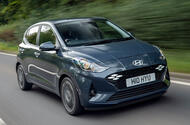
South Koran supermini touts frugality, style and a low starting price - is it a bargain or just plain cheap?
Is now the right time to buy a small city car like the Hyundai i10?After several years on sale, the formula for these increasingly rare beasts has been refined, the mechanicals updated and the interiors tweaked to make almost all of the established ones conduct themselves as though they were from the class above.The i10, having received a facelift with some meaner, more assertive looks, a revised range of engines and the promise of 'big-statement' design cues and new on-board tech, appears, on paper, to be a very well-rounded product. It helps, too, that it finds itself with precious few rivals left in the supermini segment, including the MG 3, Toyota Aygo X, Dacia Sandero, and technically-related Kia Picanto.Relatively speaking, that isn’t an extensive list - and the i10 appears to be in a better position to beat them now than ever before. It’s worth bearing in mind, though, that each of them have also been sufficiently updated to make the climate into which this third-generation i10 emerges a cut-throat one. Time to see if Hyundai’s commitment to its small car formula has been worth it, then.The Hyundai i10 range at a glanceThe i10 range is broken up into three main specifications: Advance, Premium and N Line. Entry-level Advance cars come with cruise control, an 8.0in touchscreen with Apple CarPlay and Android Auto, as well as a rear-view reversing camera, cruise control and a digital instrument cluster, while Premium adds ambient lighting, voice commands, heated front seats and wireless mobile charging. N Line is treated to meaner front bumpers, red accents, 16in alloys and racier trim pieces inside.There are three engines available: a 1.0-litre naturally aspirated three-cylinder with 62bhp and 68lb ft, a 1.2-litre four-pot with 83bhp and 87lb ft, and a turbocharged version of the 1.0-litre producing 89bhp and 124lb ft. The 1.0-litre turbo is only available on N Line cars mated to a five-speed manual gearbox, while the naturally aspirated (N/A) 1.0-litre and 1.2-litre engines can be had on Advance or Premium cars, sending power via a five-speed manual or five-speed automated manual gearbox.As for its suspension, the i10 doesn’t deviate from the established class formula. MacPherson struts are employed at the front axle and a torsion beam sits across the rear. The rear torsion bar is now U-shaped as opposed to triangle-shaped to improve stability, while a stronger steering torsion bar and quicker steering gear should help to sharpen steering response.

